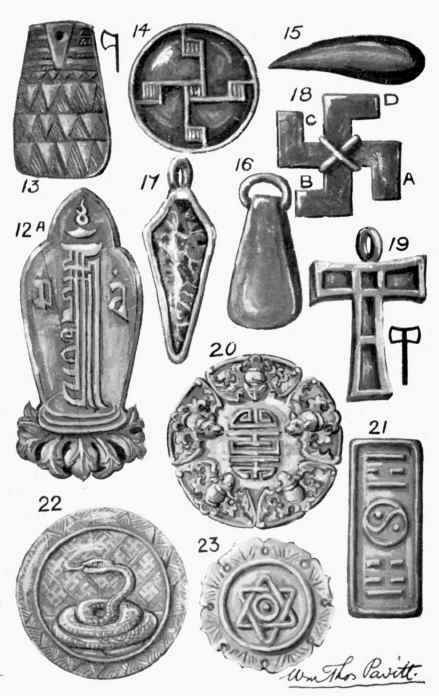Chapter III. Ganesa The Elephant-Headed - The Eight Glorious Emblems Of Buddha
Description
This section is from the book "The Book Of Talismans, Amulets And Zodiacal Gems", by William Thomas & Kate Pavitt. Also available from Amazon: The book of talismans, amulets and zodiacal gems.
Chapter III. Ganesa The Elephant-Headed - The Eight Glorious Emblems Of Buddha
OF the many and various Symbols and Talismans which have come down to us through the ages, the Tau Cross is one of the most ancient, and is undoubtedly the prototype of all modern crosses; it probably had its origin in the double-axe hieroglyphic used by primitive man, and symbolised the Divine attributes of rule and power appertaining to the single axe as mentioned in the previous chapter, and is still recognised as an emblem of authority in the form of the Gavel, or Mallet, with which the auctioneer conducts sales of property and the chairman controls meetings both in public and in the various lodges of secret societies. Formerly it was also universally worn as a talisman of powerful efficacy to protect its wearer from diseases of an inflammatory nature and against bites of serpents and other venomous reptiles (see Illustration No. 19, Plate I). Moses, who from his training in the Egyptian temples would be familiar with its symbolic significance, also used this cross, with the brazen serpent attached, to save the Israelites in the Wilderness when they were afflicted by the fiery serpents. This form of cross is to be found in all known religions of both hemispheres, and has ever been regarded as the symbol of eternal life and of regeneration, and in relation to this, John Dudley, writing in 1846, says: "that such deep mysterious meaning was possibly intended by our Saviour dying upon the Cross, giving spiritual life and immortality to all mankind." It was also the mark mentioned in Ezekiel ix. 4 which was set in the foreheads of those destined for exemption from Divine punishment in Jerusalem; and the Tau is conspicuous in various old stained-glass representations of the subject depicted as described in Scripture. A further instance of significance is that it also figured on the roll-call of the Roman Legions, a Tau Cross being placed against the names of all those who had survived the battle, and a Theta against the slain.

Primeval, Chinese, Indian And Thibetan Talismans.
Plate 1
The Tau Cross
The Tau Cross was also the sign adopted by Anthony the Copt, an Egyptian hermit gifted in the cure of Erysipelas (a diffusive inflammatory affection of the skin) and as an Amulet against St. Anthony's Fire, as this disease was subsequently called, this cross came into great favour, particularly among the Jews, who used it in conjunction with various magical formulas both for Erysipelas and Epilepsy, or the falling sickness, as stated by the Rev. C. W. King. We also learn from Grose that a brotherhood known as the Order of St. Anthony was instituted in 1095 by one Gaston Frank. The friars of this order made it their object in life to minister to those afflicted with St. Anthony's Fire, the relics of this saint being believed to be most efficacious in the cure of this complaint. We are also told that this fraternity wore a black habit with the letter T in blue on their breasts, this symbol being known as St. Anthony's Cross. As this saint was habitually invoked for the cure of Epilepsy as well as Erysipelas, the Tau Cross became regarded as a Talisman against both maladies.
In the Archceological Journal we note the following:-
"Among Stothard's effigies are those of Sir Roger de Bois and lady, each of whom wears on the right shoulder a circular badge graven with a Tau Cross on which appears the word anthon," thus testifying to the fact that Sir Roger also belonged to the Brotherhood, whilst in Ireland to this day St. Anthony's Cross is still used as a charm against sickness.
Continue to:


